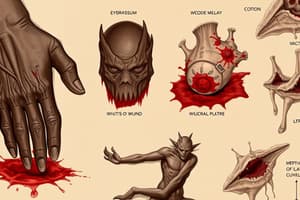Podcast
Questions and Answers
What are the mechanisms of injury?
What are the mechanisms of injury?
- Traumatic
- Overuse
- Idiopathic/Insidious
- All of the above (correct)
What is the definition of a contusion?
What is the definition of a contusion?
- A compression injury involving blood and lymph accumulation (correct)
- A tear of a ligament
- A result of a fracture
- An inflammation of a bursa
What is the mechanism of injury (MOI) for a contusion?
What is the mechanism of injury (MOI) for a contusion?
Direct blow
Ecchymosis is a hemorrhagic spot on skin forming a non-elevated, round or irregular ____ patch.
Ecchymosis is a hemorrhagic spot on skin forming a non-elevated, round or irregular ____ patch.
What may cause ecchymosis?
What may cause ecchymosis?
What are the signs and symptoms of hematoma?
What are the signs and symptoms of hematoma?
What is myositis ossification?
What is myositis ossification?
What is the definition of bursitis?
What is the definition of bursitis?
What causes strains?
What causes strains?
What are the signs and symptoms of a Grade 2 strain?
What are the signs and symptoms of a Grade 2 strain?
Tendinopathy is a general term indicating a tendon pathology characterized by pain, swelling and/or ____ of the tendon.
Tendinopathy is a general term indicating a tendon pathology characterized by pain, swelling and/or ____ of the tendon.
What causes sprains?
What causes sprains?
Flashcards are hidden until you start studying
Study Notes
Injury Classification
- Injuries can be classified based on mechanism (traumatic, overuse, idiopathic) and timing (acute, chronic, recurrent).
- Acute injuries result from a sudden incident with a clear cause, while chronic injuries show prolonged healing issues and insidious onset.
- Recurrent injuries arise after complete healing but may lead to further episodes due to residual instability.
Contusion
- A contusion is a compression injury characterized by blood accumulation in tissues.
- Types of contusions include subcutaneous, intramuscular, and periosteal.
- Mechanism of injury (MOI) typically involves a direct blow.
- Signs include tenderness, movement pain, swelling, discoloration, and possible hematoma formation.
Ecchymosis
- Defined as a hemorrhagic spot leading to non-elevated, irregularly shaped purple/red/blue patches on the skin.
- This condition can occur due to trauma or may be associated with diseases.
- Generally painless with characteristic discoloration and usually speckled with white.
Hematoma
- A hematoma refers to a localized collection of clotted blood within tissues.
- Types include intramuscular, intermuscular, and subperiosteal hematomas.
- MOI is often direct trauma, resulting in tenderness, swelling, discoloration, and limited range of motion (ROM).
Myositis Ossification
- A complication arising from muscle hematomas, leading to calcification within the muscle.
- Caused by direct blows or repetitive trauma.
- Symptoms may include pain, a firm mass, and limited ROM depending on lesion severity and location.
Bursitis
- Inflammation of a bursa, which can occur due to direct blow or repetitive friction.
- Symptoms encompass pain, a painful arc during movement, swelling, heat, and redness.
Strains
- Defined as stretches or tears of muscles or tendons.
- Mechanism of injury involves overstretching or excessive load.
- Symptoms include localized tenderness, tightness, swelling, decreased strength, and possible visible defects.
Strain Grades
- Grade 1 Strain: Minor stretching, little to no loss of function (LoF), mild pain, and minimal swelling.
- Grade 2 Strain: Moderate damage, mild to moderate LoF, decreased strength, and possible discoloration/swelling.
- Grade 3 Strain: Complete tear with substantial LoF, possible initial lack of pain, visible defects, discoloration, and swelling.
Tendinopathy, Tendinosis, and Tendinitis
- Tendinopathy is a general term for tendon pathologies characterized by pain and swelling.
- Tendinosis refers specifically to degenerative changes in a tendon without inflammation.
- Tendinitis indicates the presence of inflammation in a tendon.
Sprains
- Defined as stretches or tears of ligaments or joint capsules.
- MOI typically involves overstretching or excessive loads.
- Symptoms present as tenderness, pain during movement, instability, swelling, edema, and joint laxity.
Studying That Suits You
Use AI to generate personalized quizzes and flashcards to suit your learning preferences.




